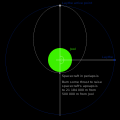Laythe
Laythe is the first of the five natural satellites of Jool. Although mostly covered in seas, Laythe has numerous rocky, sandy islands. Laythe is tidally locked to Jool. Synchronous orbits around Laythe are not possible, as they would lie outside of its SOI, at a radius of 5,186,399 meters. A circular archipelago that is prominent in maps suggests that Laythe suffered a massive impact in its distant past.
Achieving a stable orbit around from sea level requires a delta-V of ≈2800 m/s.
Laythe has no real-world analogue. In the real-world Jupiter system, the moons Ganymede, Europa and Io form a group with an orbital resonance just like KSPs Tylo, Vall and Laythe. But while Tylo and Vall have a certain resemblance to their real-life counterparts, Laythe is very unlike the volcanic, atmosphere-less, dry Io. Though Laythe has liquid water on its surface, the temperature there is below 0 degrees Celsius. This means that Laythe's oceans must contain another compound, most likely ionic, such as salt.
According to developer NovaSilisko, Laythe is planned to have volcanic, probably cryovolcanic, activity and high radiation levels in later versions, making it a much more hostile moon than now (0.23[outdated]).[1][2]
Atmosphere
Laythe's atmosphere begins at 55,262 meters and is slightly thicker than Kerbin's. It is the only moon in the game which has an atmosphere.
Like all other atmospheres in the game, Laythe's atmosphere fades exponentially with increasing altitude (with a scale height of 4000 m). In general, the atmospheric pressure on Laythe at an altitude expressed in meters is:[3]
With proper aerobraking near Laythe and Jool, reaching Laythe may require the least delta-V of all of Jool's moons. When approaching Jool on a Hohmann transfer orbit from Kerbin, aerobraking with a Jool periapsis of 119.5 km will put your apoapsis roughly near Laythe's orbit.
Another way is to approach Laythe directly, with proper timing and orbit adjustments done on the way to Jool. Laythe's orbital period makes it easy target to time and allows less Δv on arrival (only 2000 m/s), thus aerobraking on Laythe is lighter than on Jool. Diving to ~22 km will almost circularize the (retrograde) orbit.
Landing on higher points of Laythe's surface has to be done with a help of retro burns as parachutes alone are not enough to sufficiently lower velocity for landing.
Jet engines work in Laythe's atmosphere as it contains oxygen. However, their air intake efficiency is lower.
Laythe is mostly ocean. There are many craters on its surface, and some of the largest features it has may be related to impacts.
Reference Frames
| Time warp | Minimum Altitude |
|---|---|
| 1× | Any |
| 5× | 50 000 m (above the atmosphere) |
| 10× | 50 000 m (above the atmosphere) |
| 50× | 60 000 m |
| 100× | 120 000 m |
| 1 000× | 240 000 m |
| 10 000× | 480 000 m |
| 100 000× | 600 000 m |
Gallery
Changes
- Initial Release
Notes
- ↑ Forumpost from NovaSilisko
- ↑ Post from NovaSilisko
- ↑ A LV-N Atomic Rocket Motor has a specific impulse of 220 in 1 atm, 800 in vacuum, and the following at various Laythe altitudes:
altitude (m) 600 1464 1800 2238 2698 3296 4104 16435 specific impulse 400.7 478.2 504.2 534.8 563.7 596.5 633.7 792.4
















